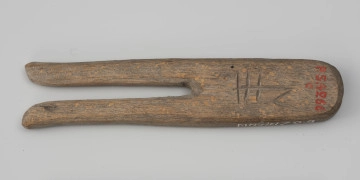
Salmon fishing line with a mark
1901 — 1950
National Museum in Szczecin
Part of the collection: Traditional fishing
Some types of floats, instead of raising the edges of the nets to the surface of the water, function as markers indicating their position within the fishing area. In Kashubia, a float with a pole topped with a flag is known by the names preka or znak, and due to being topped with a piece of material, it is also called a sztenderek. These markers are still in use today. Such marker buoys consist of long poles with a float placed halfway up and a piece of fabric, often red, at the top. In the past, instead of fabric, they could have a simple piece of material in the appropriate colour, leather, or a rod, and at night, a lantern. The word preka literally refers to the stick, rod, or pole itself. The pole was made of willow or another light wood, the float from cork, and stones or chains were attached underneath to weigh it down. Although marker buoys were used to indicate the locations where nets like those for flounder, sprats or herrings, or specialised tools called takle for salmon were set, fishermen often carved their personal signs on the markers to identify the owner of the equipment. The Pomeranian Ethnography Department of the National Museum in Szczecin holds 9 marker buoys. The example here was purchased for the collection in 1949. It does not bear a fisherman's mark, and the metal weight is missing. However, an interesting fact is that this marker is the only one in the collection with a black flag, which indicates nets set on the seabed. Małgorzata Kłosińska-Grzechowiak
Other names
preka, sztenderek (small flag pole), stender (Kashubian)
Author / creator
Object type
marker buoy, identifying artifacts
Technique
carpentry techniques, hollowing
Material
wood, canvas, iron, cotton fabric
Origin / acquisition method
purchase
Creation time / dating
Creation / finding place
Owner
The National Museum in Szczecin
Identification number
Location / status

1901 — 1950
National Museum in Szczecin

1901 — 1950
National Museum in Szczecin

1890 — 1950
National Museum in Szczecin
DISCOVER this TOPIC
Castle Museum in Łańcut
DISCOVER this PATH
Educational path